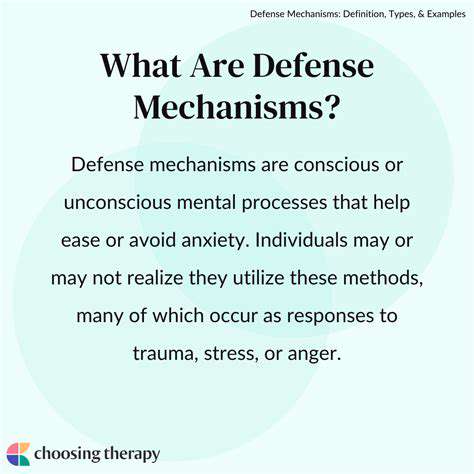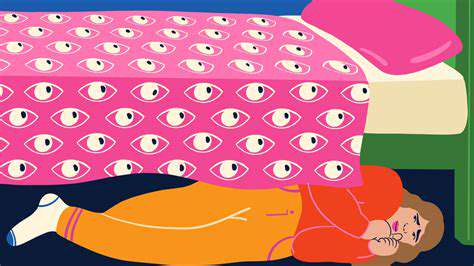The Hidden Sources of Dread: Exploring Its Psychological Roots
The Psychological Mechanisms of Dread

The Nature of Dread
Dread is an emotional response that can arise from various situations, often characterized by a sense of impending doom or fear. It is distinct from general anxiety, as it often relates to a specific event or circumstance that is perceived as threatening. This emotion can be deeply tied to one's psychological state and past experiences. Understanding the nature of dread involves recognizing how it manifests in our thoughts and behaviors.
People may experience dread in different ways, such as feelings of helplessness, tension in the body, or pervasive negative thinking. It can be an overwhelming sensation that makes it difficult to concentrate or engage in daily activities. Recognizing these signs is essential for addressing and managing dread effectively.
The feeling of dread can also limit one's ability to enjoy life. When consumed by dread, individuals may isolate themselves, fearing potential outcomes or experiences. This avoidance can exacerbate feelings of loneliness and despair.
Ultimately, the nature of dread requires a multifaceted approach to understand and cope with it. Exploring the root causes can lead to better management strategies and improved quality of life.
The Role of Past Experiences
Previous experiences, especially traumatic ones, play a significant role in shaping our current emotional responses, including dread. Individuals who have faced significant loss, betrayal, or failure may find themselves more susceptible to feelings of dread in similar situations. This conditioning can lead to a heightened state of alertness when faced with challenges.
For many, dread can stem from unresolved issues related to these past experiences. These issues may create a mental framework that amplifies fears and negative expectations. Individuals may unconsciously repeating patterns that reinforce their feelings of dread.
Understanding the impact of past experiences on present emotions is crucial for healing. Therapeutic interventions often focus on unpacking these experiences to help individuals gain relief and perspective.
By confronting and reframing these past experiences, individuals can begin to alter their perception of threats and reduce feelings of dread in their lives.
Cognitive Distortions and Dread
Our thoughts significantly influence our emotions, and in the case of dread, cognitive distortions can amplify negative feelings. Common distortions include catastrophizing, where individuals expect the worst possible outcome, and overgeneralization, where they apply one negative experience to all future situations. These thought patterns can create a cycle of dread that is hard to break.
Recognizing cognitive distortions is the first step in counteracting their effects. Individuals can learn to challenge their negative thoughts by examining evidence and considering alternative outcomes.
Engaging in cognitive-behavioral strategies can help individuals restructure their thinking patterns. Tools such as journaling and mindfulness can cultivate awareness of one's thoughts, reducing the power of cognitive distortions.
By transforming how we think about potential threats, we can alleviate the distress associated with dread and foster a more optimistic outlook on life.
Environmental Influences on Dread
The environment we inhabit can also contribute to feelings of dread. Stressful living conditions, such as financial instability, unsafe neighborhoods, or lack of social support, can exacerbate anxiety and dread. These external factors can create a pervasive sense of instability and fear.
An individual’s environment can trigger their psychological mechanisms, leading to heightened vigilance and emotional reactivity. Social comparisons and cultural expectations can further amplify these feelings.
Creating a supportive and stable environment is critical to mitigating the effects of dread. Individuals can work towards establishing safe spaces, both physically and emotionally, where they can find respite from overwhelming feelings.
Ultimately, positive environmental changes can have a profound impact on emotional well-being, helping to alleviate the fear and anxiety that often accompany dread.
Strategies for Managing Dread
Effective strategies to manage dread often focus on addressing both the emotional and cognitive aspects of the experience. One approach is to engage in mindfulness practices, which can help individuals remain present and reduce overthinking about potential outcomes. This allows for a better focus on the here and now rather than on distant, fearful possibilities.
Another key strategy is cultivating social support networks. Discussing feelings of dread with trusted friends or family can provide relief and fresh perspectives, reducing the intensity of the emotion.
In addition, seeking professional help through therapy may be beneficial. Therapeutic modalities such as exposure therapy or cognitive-behavioral therapy are tailored to help individuals confront and manage their feelings of dread effectively.
Lastly, developing healthy coping mechanisms, such as exercise, art, or journaling, can provide productive outlets for emotions associated with dread. Creating a balanced routine that integrates these strategies can empower individuals to reclaim control over their feelings and live more fully.
Strategies for Managing Dread

Understanding the Nature of Dread
Dread is often characterized by a profound sense of unease or impending doom. It can be triggered by various factors, including personal experiences, societal issues, or even existential threats. Recognizing the triggers of dread can help in identifying its manifestations in our lives. Understanding its nature can also lead to more effective coping strategies.
This feeling often stems from an underlying fear of the unknown, which can permeate various aspects of life. It may manifest as anxiety about future events, concerns about personal safety, or feelings of inadequacy. Awareness of how dread influences behavior is crucial for personal growth and mental health.
It's essential to differentiate between normal apprehension and overwhelming dread. While some level of caution is healthy, persistent dread may require attention and intervention. A clear understanding of this distinction is valuable for self-assessment.
Ultimately, acknowledging the presence of dread allows individuals to address it directly. This approach promotes a proactive rather than reactive stance toward mental health and wellbeing, enabling better control over one's emotional landscape.
Recognizing Personal Triggers
Every individual has unique triggers that can provoke a sense of dread. Common triggers may include major life changes such as job loss, relationship breakdowns, or the death of a loved one. It’s vital to explore personal history to identify these sources effectively.
Keeping a journal can be an effective tool for tracking feelings of dread. By documenting emotions and circumstances surrounding these feelings, one may gain insight into possible triggers. This practice encourages self-reflection and can reveal patterns that might not be immediately apparent.
Engaging in conversations with trusted friends or mental health professionals can also aid in recognizing triggers. External perspectives often provide clarity that personal reflection may miss. This collaborative approach to understanding dread can be empowering.
Once triggers are identified, individuals can formulate personalized strategies to manage their reactions. This proactive approach not only alleviates feelings of dread but also fosters resilience in facing life's challenges.
Developing Coping Mechanisms
Effective coping mechanisms are essential for managing dread and its effects on mental health. Mindfulness practices, such as meditation and deep breathing, can help ground individuals in the present moment. These techniques assist in reducing the intensity of dread by fostering a sense of calm.
Physical activity also plays a significant role in managing feelings of dread. Exercise releases endorphins, which can counteract anxiety and improve mood. Regular physical activity creates a positive feedback loop that can reinforce emotional well-being.
Creative outlets like art, writing, or music can provide an avenue to express feelings associated with dread. Engaging in creative activities can serve as therapy, allowing individuals to externalize their emotions in a constructive manner. This process can be both cathartic and healing.
Establishing a support network can alleviate feelings of isolation that often accompany dread. Sharing experiences and coping strategies with others offers validation and understanding, reinforcing the idea that one does not have to face these emotions alone.
Seeking Professional Help
There are instances when managing dread on your own becomes overwhelming. Knowing when to seek professional help is a critical step in addressing mental health challenges. Mental health professionals can offer tailored strategies and tools for coping with persistent feelings of dread.
Therapeutic approaches such as cognitive-behavioral therapy (CBT) can be highly effective for addressing dread. This form of therapy helps individuals identify and challenge negative thought patterns, empowering them to reshape their responses to fear and anxiety. Professional guidance can foster significant changes in how one perceives dread.
Support groups also provide a valuable resource for those grappling with dread. They create a safe space for individuals to share experiences and learn from one another. This collective wisdom often proves beneficial in developing effective coping strategies.
Ultimately, seeking help signifies strength and a commitment to mental health. Understanding that it's okay to need support is fundamental in overcoming the debilitating effects of dread.
Building Resilience Against Dread
Resilience is the ability to bounce back from challenges and adversities. Cultivating resilience can significantly mitigate feelings of dread and anxiety. Developing a positive mindset, viewing challenges as opportunities, can transform how one deals with negative emotions.
Setting realistic, achievable goals can also support resilience. Breaking tasks into manageable steps allows individuals to experience small victories, fostering a sense of accomplishment. This approach builds confidence and reduces feelings of dread associated with overwhelming tasks.
Practicing self-compassion is another essential aspect of resilience. Treating oneself with kindness during difficult times can alleviate feelings of dread rooted in self-judgment. By embracing imperfection, individuals can cultivate a more forgiving outlook toward their experiences.
Lastly, establishing a consistent routine can create a sense of normalcy in times of uncertainty. Routines provide structure that can be comforting in the face of dread, reducing anxiety while promoting healthy habits and stability in daily life.